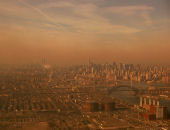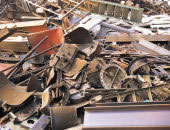| |
|
|
|
|
| |
|
|
Few of us seem to remember the fact that a very finite envelope of air surrounds our world. Once mired with significant levels of pollution, there is no recovery. It will never be the same again: “And the earth shall wax old like a garment, and they that dwell therein shall die in like manner” (Isaiah 51:6). The Book of Isaiah, which contains some of the most profound prophetic messages in the Bible, tells us that in the days before our Lord returns, the earth will lose its freshness and luster just like an old, worn garment. This is exactly what we have seen happen in recent years with rising pollution and global warming. It is noteworthy that Isaiah 51:6 also says, “lift up your eyes to the heavens, and look upon the earth beneath.” On May 30, 2001, BBC News reported that data |
|
| |
captured from NASA’s Terra spacecraft, which circles the earth 16 times a day, showed that pollution from forest fires and burning of fossil fuels is billowing across entire continents and oceans. John Gille, lead investigator at the National Center for Atmospheric Research said, “With these new observations, we clearly see that air pollution is much more than a local problem….It’s a global issue.” |
| |
Many of us tend to ignore the implications of our own actions in relation to air pollution, viewing them from a local rather than global perspective. We all know the effect that a single cigarette can have in an enclosed room. It can literally make the air toxic. The World Health Organization (WHO) has reported that exposure to second-hand smoke increases the mortality from lung cancer in non-smokers by 20 – 30 percent. Now multiply that one cigarette by the tens of millions that burn each day around the world within our enclosed atmosphere. Believe it or not, the pollution is significant – mainly because it is unnecessary. It is just another example of our obsession with burning things for gratuitous purposes, or for effect. The irony is that this rather superfluous source of pollution is miniscule in comparison to the countless millions of automobiles, smokestacks, and open fires that burn day in and day out. On August 16, 2001, CBS News reported that a study by Carnegie Mellon University researchers found that air pollution from exhaust pipes and smoke stacks is already killing people worldwide. WHO estimates that three million people die each year because of air pollution, representing 5 percent of the 55 million deaths occurring annually worldwide. WHO also reports that this number may rise to as high as eight million by 2020. Between 30 and 40 percent of asthma cases and 20 – 30 percent of all respiratory diseases are also attributed to air pollution. A report released by the Earth Policy Institute on September 17, 2002 echoed WHO’s observations, pointing out that deaths from air pollution now exceed traffic fatalities by three to one. The number of deaths from air pollution is also equivalent to the total combined fatalities from breast and prostate cancer – two of the leading forms of cancer today. |
| |
Many of us tend to ignore the implications of our own actions in relation to air pollution, viewing them from a local rather than global perspective. We all know the effect that a single cigarette can have in an enclosed room. It can literally make the air toxic. The World Health Organization (WHO) has reported that exposure to second-hand smoke increases the mortality from lung cancer in non-smokers by 20 – 30 percent. Now multiply that one cigarette by the tens of millions that burn each day around the world within our enclosed atmosphere. Believe it or not, the pollution is significant – mainly because it is unnecessary. It is just another example of our obsession with burning things for gratuitous purposes, or for effect. The irony is that this rather |
 |
superfluous source of pollution is miniscule in comparison to the countless millions of automobiles, smokestacks, and open fires that burn day in and day out. On August 16, 2001, CBS News reported that a study by Carnegie Mellon University researchers found that air pollution from exhaust pipes and smoke stacks is already killing people worldwide. WHO estimates that three million people die each year because of air pollution, representing 5 percent of the 55 million deaths occurring annually worldwide. WHO also reports that this number may rise to as high as eight million by 2020. Between 30 and 40 percent of asthma cases and 20 – 30 percent of all respiratory diseases are also attributed to air pollution. A report released by the Earth Policy Institute on September 17, 2002 echoed WHO’s observations, pointing out that deaths from air pollution now exceed traffic fatalities by three to one. The number of deaths from air pollution is also equivalent to the total combined fatalities from breast and prostate cancer – two of the leading forms of cancer today. |
| |
Air pollution is growing at an alarming rate, particularly in the underdeveloped nations of the world. On June 11, 1999, BBC News reported that, “a thick brown cloud of pollution the size of the United States has formed over the Indian Ocean, contributing to acid rain and cutting the amount of sunlight reaching the water.” The cloud, which extends three kilometers (1.86 miles) into the atmosphere, contains pollutants from vehicle and industrial emissions and could wreak havoc with the climate in the region, as well as with the marine life. Scientists at the Scripps Institution of Oceanography in San Diego say that the pollution is unprecedented in the region’s history and that it will only increase as the population of Asia grows. On August 11, 2002, BBC News filed another report on the persistent haze over the continent of Asia stating that it poses a widespread threat to rainfall and farming, placing “hundreds of thousands of people in jeopardy.” As mentioned earlier in this chapter, a brown cloud now extends to the tops of the Himalayas, an area that at one time boasted the most pristine air on earth. Scientists refer to this new and startling development as a regional and global menace, the impact of which will worsen over the next 30 years. |
| |
| The air we breathe has indeed changed radically over the course of this past century. When I was a child, I occasionally visited relatives in Los Angeles. I can vividly recall the beauty of the mountains surrounding the metropolitan area. They were clearly visible, as was the skyline of downtown Los Angeles. Today, there are times when you can scarcely see the buildings in the downtown area from as little as a mile away, much less the |
 |
| mountains in the distance. Warnings are frequently issued urging residents to avoid strenuous outdoor exercise or deep breathing, because of health risks imposed by the smog. Although there have been some improvements made in recent years to control this urban blight, the visible change in air quality over just the last two decades is absolutely astonishing. It seems that each time I visit the area, the reddish-brown haze that obscures the scenery gets worse. But as bad as the Los Angeles air has become, it almost pales in comparison to the air quality in China. On a recent visit to that country, I was astounded by the conditions in some of the major cities. After about two weeks in Beijing, I developed pneumonia from breathing the heavily polluted air, and had to secure emergency transport back to the United States. |
| |
Air pollution is not the only form of environmental deterioration we have witnessed in recent years. On April 5, 2000, the Associated Press reported that, according to the National Academy of Sciences, marine life is being killed and marshlands damaged in more than a third of the nation’s coastal areas because of excess algae growth from runoff. On August 8, 2001, CBS News announced that coastal pollution had closed beaches near oceans, bays, the Great Lakes, and rivers almost twice as often as the previous year, according to a report by the Natural Resources Defense Council. The report also stated that there was a 40 percent increase in the number of beaches reporting pollution problems from an unknown source. On July 24, 2002, BBC News reported that serious water pollution incidents had increased 50 percent from the previous year in England and Wales. The report claimed that pollution from farms accounted for 27 percent of the most serious problems. On January 26, 2003, USA Today reported that half the world’s coastal areas, where one billion people live, have deteriorated because of pollution and over-development. |
| |
During the past few years, there have been serious concerns raised about increasing pollution of oceans and groundwater resulting in damage to aquatic food sources and depletion of available clean drinking water. Last year, environmental watchdog agencies and marine biologists warned that the explosive growth of jellyfish populations in oceans and seas around the world is a sign that nutrient pollution and global warming are destroying |
 |
| marine ecosystems. Low oxygen dead zones in the world’s coastal waters have increased by 100 percent since 1995 due to excessive algae growth caused by farm runoff. Common household drugs and chemicals have also caused damage to aquatic environments. Over 80 percent of United States rivers and streams are contaminated with a variety of pharmaceutical drugs including hormones, antibiotics, and antidepressants, along with household cleaners and other chemicals. |
| |
Toxic wastes have also contributed to pollution of water sources and present serious hazards to residents of some communities. Many may recall the infamous Love Canal incident in the 1970s that changed the lives of local residents and shocked the nation. Beginning as early as the 1920s, the City of Niagara Falls, New York and later the Hooker Chemical Company, dumped 21,000 tons of organic solvents, acids, and pesticides into the canal. After many years of toxic waste dumping, the local community began to experience an astronomical rise in birth defects, miscarriages, cancers, and severe respiratory disorders. Toxic chemicals that bubbled up through the ground reportedly burned children and animals and caused explosions. It was a nightmare. In 1980, the federal government had identified 248 different chemicals in the dumpsite, and today the count stands at over 400. Although arguably one of the most extreme examples in U.S. history of toxic waste dumping and its consequences, this activity still persists in many areas today, and in fact has increased in recent years.
On June 25, 1998, the Inter Press Service (IPS) filed a report on the dumping of large amounts of hazardous wastes by Mexican industries along the U.S. – Mexican border. The toxic wastes contaminated streams and groundwater. Episodes of dumping and subsequent investigations have been going on in that area for several years. On July 12, 2000, the Toronto Globe announced that Ontario’s “feeble environmental laws” allowed the province to be used as a dumping ground for toxic wastes, potentially exposing citizens to deadly carcinogens. A report by the Canadian Institute for Environmental Law and Policy stated that Ontario’s toxic waste imports increased a staggering 138 percent between 1994 and 1998. On December 6, 2000, the Environmental Protection Agency (EPA) announced plans to clean up dangerous toxins along a 40-mile stretch of the Hudson River in upstate New York, according to CNN. The $460 million clean-up effort was designed to address 30 years of legal PCB dumping by two General Electric Company manufacturing plants. It is estimated that the plants dumped about 1.1 million pounds of the chemicals into the Hudson River between 1947 and 1977. PCBs are highly toxic and carcinogenic chemicals used as coolants in heavy electrical equipment. Their production has been banned in the United States since the late 1970s.
|
| |
Nuclear waste is yet another major problem in the world today. As a result of the production and testing of nuclear weapons spurred on by the Cold War, and the proliferation of nuclear power plants, we are now saddled with a stockpile of radioactive materials and wastes that require storage or disposal. There are vast areas in this country that have already been contaminated as a result of nuclear weapons production and testing, and an effort still wages to determine how to make these areas safe or livable for current and future generations. The former Soviet Union’s Chernobyl nuclear reactor accident in 1986 – the worst in history, illustrated to the world the devastating effects of widespread radioactive contamination. The long-term effects of this incident are still being felt today. Exposure to even low levels of radioactive material can cause cancer, birth defects, and a variety of degenerative and autoimmune diseases. Larger doses can be lethal by causing radiation sickness – a rapidly progressing disease process resulting in decreased white blood cell count, nausea, hair loss, and finally death.
The toxic half-life of some nuclear materials can range up to several million years. Half-life is the time required for half the amount of a radioactive substance to disintegrate. When you consider the amount of nuclear material stockpiled today including many unused or dismantled nuclear weapons, the dilemma becomes frighteningly evident. What do we do with these materials? This question has yet to be answered satisfactorily. Debates have raged on for years about safe storage facilities and practices for handling nuclear wastes. In 1987, the federal government elected to build a storage site at Yucca Mountain in Nevada, located about 100 miles northwest of Las Vegas. About $6.8 billion has already been invested in the project, but efforts to fully activate it have drawn fire from many in Nevada who do not want nuclear wastes in their backyard. The turmoil was further compounded by the September 11 tragedy, which spurred the government to plan the storage of highly radioactive wastes at the facility, rather than the low to medium-level wastes originally slated for storage. A January 15, 2002 ABC News story entitled “Nevada Mountain to be Nuclear Garbage Can” reported that the government’s decision to store high-level wastes at the site drew resounding protests from elected officials in Nevada, despite the anticipated $50 billion windfall in jobs and income it could bring to the state.
|
|
|
| |
|
|
| |
|
The mortality rate for human beings from air pollution has been fairly well documented. But no one can even wager a guess about the number of people who have died as a direct result of exposure to pesticides in foods, toxic chemicals, or nuclear wastes. Human beings, however, are not the only ones being affected by this scourge. On March 15, 1998, CNN reported that Florida researchers are concerned about a significant decline in the alligator population due to the introduction of pesticides and |
other chemicals into the lakes and waterways where they live. The pesticides, fertilizers, and phosphorus runoff from nearby agricultural sites seem to impair the alligators’ ability to reproduce by lowering growth and reproductive hormone levels. On June 4, 1999, ABC News carried a story about dolphins dying in the Mekong River in Cambodia. Thousands of dolphins populated the river at one time, but due to pollution and other factors their numbers have been reduced to a mere one hundred or so, making them one of the most endangered of all cetaceans. On February 28, 2000, the Associated Press reported that flamingos are dying in alarming numbers at Lake Bogoria in Kenya’s Rift Valley. According to conservationists, a mysterious disease caused by pollution is killing tens of thousands of the birds. In an interview with Reuters, Gideon Motelin, who specializes in flamingo studies at Kenya’s Egerton University, said that up to nine or 10 heavy metals were found in every bird from which tissue samples were collected. “It is not normal to find arsenic, lead, mercury, chromium and copper in the livers and kidneys of these birds,” he said. Traces of pesticides were also discovered in the tissues of the dead birds. |
| |
 |
There are many other forms of pollution affecting our world. Some of these are less obvious than others, and many are oblivious to their impact. The light generated by our major cities affects our ability to see the night skies, and frequently impacts the darkness of our forest retreats. Urbanization produces constant noise, often shattering nerves and creating unnecessary stress and anxiety. On June 27, 1999, the Los Angeles Times reported that noise also causes a serious threat to sea creatures. The report |
|
stated that acoustic pollution from ships, oil drilling and military sonar, could cause deterioration of marine habitats. We must bear in mind that until man developed the technology that exists today, our oceans, forests, and even our cities were peaceful havens without the boisterous incursions that we now face.
|
| |
Our world is besieged with an environmental pollution problem of almost incomprehensible magnitude. Our air is not fit to breathe. Our water is contaminated with hazardous chemicals. Toxic materials and nuclear wastes present insurmountable disposal problems. Tainted groundwater and pesticide residues have contaminated our food supply worldwide. Of all the signs of our Lord’s approaching return, pollution may perhaps be the most prominent. And guess what? The problem of environmental pollution and its impact has grown most conspicuously over the past decade alone. Reports from government regulatory agencies echoed through the news media invariably show that major environmental ramifications of pollution have surfaced on a planetary scale only since the beginning of the 1990s. Are you surprised? |
|
|
| |
|
|
| |
Excerpt from The Rational Christian
Environmental Pollution (Isaiah 51:6)
Copyright © 2006 Christopher Creek Publishing. All Rights Reserved. |
|
| |
|
|
|